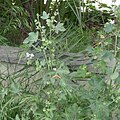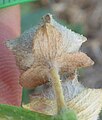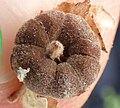
In botany, a bract is a modified or specialized leaf, especially one associated with a reproductive structure such as a flower, inflorescence axis or cone scale. Bracts are usually different from foliage leaves. They may be smaller, larger, or of a different color, shape, or texture. Typically, they also look different from the parts of the flower, such as the petals or sepals. A plant having bracts is referred to as bracteate or bracteolate, while one that lacks them is referred to as ebracteate and ebracteolate, without bracts.

Sidalcea oregana var. calva, the Wenatchee Mountains checker-mallow, is a very rare flowering plant variety that occurs only in five locations in the Wenatchee Mountains of Chelan County, Washington, United States. The plant has been placed on the Endangered species list. As of 2004, the population of the species was 11,000 individual plants.

Althaea officinalis, the marsh mallow or marshmallow, is a species of flowering plant indigenous to Europe, Western Asia and North Africa, which is used in herbalism and as an ornamental plant. A confection made from the root since ancient Egyptian times evolved into today's marshmallow treat, but most modern marshmallow treats no longer contain any marsh-mallow root.

Hibiscus trionum, commonly called flower-of-an-hour, bladder hibiscus, bladder ketmia, bladder weed, puarangi and venice mallow, is an annual plant native to the Old World tropics and subtropics. It has spread throughout southern Europe both as a weed and cultivated as a garden plant. It has been introduced to the United States as an ornamental where it has become naturalized as a weed of cropland and vacant land, particularly on disturbed ground.
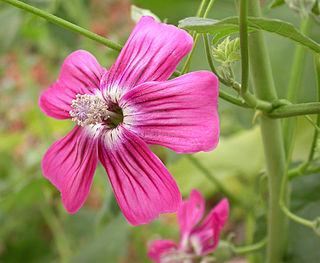
Malva assurgentiflora, formerly classified as Lavatera assurgentiflora, the island mallow, mission mallow, royal mallow, malva rosa island mallow, island tree mallow or malva rosa in Spanish, is a species of flowering plant in the mallow family.

Malva alcea is a plant in the mallow family native to southwestern, central and eastern Europe and southwestern Asia, from Spain north to southern Sweden and east to Russia and Turkey.

Malva sylvestris is a species of the mallow genus Malva in the family of Malvaceae and is considered to be the type species for the genus. Known as common mallow to English-speaking Europeans, it acquired the common names of cheeses, high mallow and tall mallow as it migrated from its native home in Western Europe, North Africa and Asia through the English-speaking world.

Malva neglecta is a species of plant of the family Malvaceae, native to most of the Old World except sub-Saharan Africa. It is an annual growing to 0.6 m (2 ft). It is known as common mallow in the United States and also as buttonweed, cheeseplant, cheeseweed, dwarf mallow, and roundleaf mallow. This plant is often consumed as a food, with its leaves, stalks and seed all being considered edible. This is especially true of the seeds, which contain 21% protein and 15.2% fat.
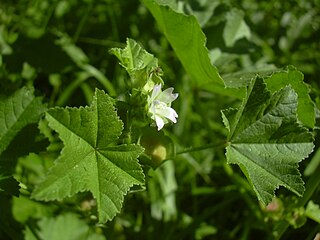
Malva parviflora is an annual or perennial herb that is native to Northern Africa, Europe and Asia and is widely naturalised elsewhere. Common names include cheeseweed, cheeseweed mallow, Egyptian mallow, least mallow, little mallow, mallow, marshmallow, small-flowered mallow, small-flowered marshmallow and smallflower mallow. It typically grows on agricultural lands and in disturbed sites such as roadsides.

Brunfelsia pauciflora is a species of flowering plant in the family Solanaceae, the nightshades. It is endemic to Brazil, and it is grown in cultivation. A shrubby perennial plant grown in gardens, its common names include today, tomorrow together, yesterday, today and tomorrow, morning-noon-and-night, kiss me quick, and Brazil raintree.
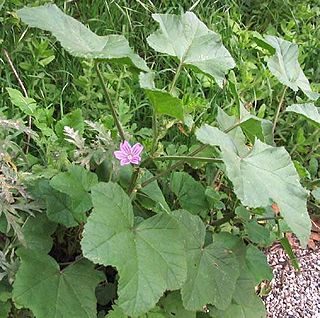
Malva nicaeensis is a species of flowering plant in the mallow family known by the common names bull mallow and French mallow.
Hibiscus cravenii is a species of flowering plant in the mallow family, Malvaceae, that is endemic to the Northern Territory in Australia.
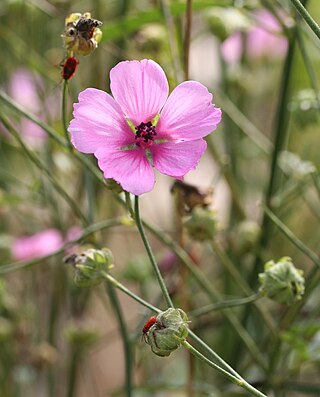
Althaea cannabina, commonly called palm-leaf marshmallow or hemp-leaved hollyhock, is a perennial herb belonging to the genus Althaea of the family Malvaceae. The leaves resemble those of hemp, hence the specific epithet cannabina ("hemp-like").

Malva punctata, commonly called spotted-stalked tree-mallow or annual tree mallow, is an annual herbaceous plant belonging to the genus Malva of the family Malvaceae.

Malva verticillata, also known as the Chinese mallow or cluster mallow, is a species of the mallow genus Malva in the family of Malvaceae found in East Asia from Pakistan to China. M. verticillata is an annual or biennial that grow up to 1.7 meters in high and can inhabit woodland areas of different soil types. The small, symmetrical flowers have five white, pink or red petals (0.8 cm) and thirteen or more stamens. Each flower has three narrow epicalyx bracts. The fruit is a dry, hairless nutlet. The leaves are simple and alternate.
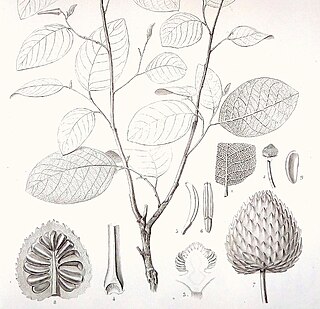
Annona bullata is a species of plant in the family Annonaceae. It is native to Cuba. Achille Richard, the French botanist who first formally described the species, named it after the bubbled appearance of the spaces between the fine network of veins in the leaves.

Annona crassivenia is a species of plant in the family Annonaceae. It is native to Cuba. William Edwin Safford, the American botanist who first formally described the species, named it after the thick tertiary veins that interconnect the secondary veins of its leaves.
Larsenianthus arunachalensis is a species of the genus Larsenianthus in the ginger family (Zingiberaceae).. It was first described in 2010 and is native to northeastern India, and Myanmar.

Malva hispanica, the Spanish mallow, is a species of flowering plant in the family Malvaceae, native to the western Mediterranean. Uniquely in its genus, Malva hispanica flowers possess a bilobed epicalyx, which is derived from an ancestral trimerous structure and represents a loss of the adaxial epicalyx lobe.

Pseuduvaria glabrescens is a species of plant in the family Annonaceae. It is native to Australia. L.W. Jessup, the botanist who first formally described the species using the synonym Pseuduvaria mulgraveana var. glabrescens, named it after the underside of its leaves which have the quality of becoming hairless as they mature.



